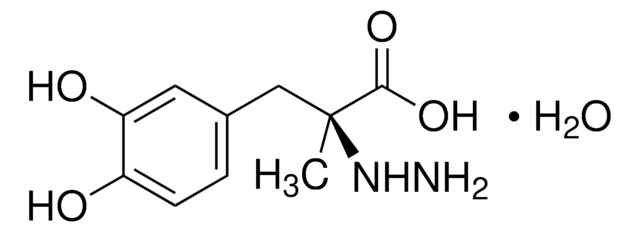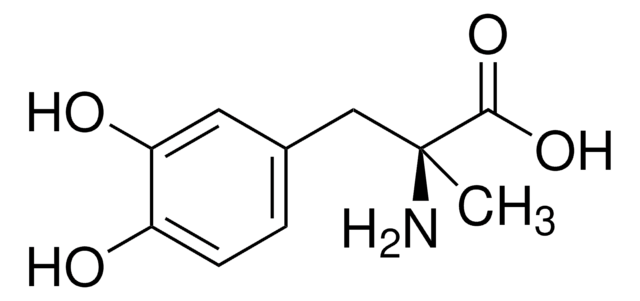Kluczowe dokumenty
1361009
USP
Levodopa
United States Pharmacopeia (USP) Reference Standard
Synonim(y):
3,4-Dihydroxy-L-phenylalanine, 3-(3,4-Dihydroxyphenyl)-L-alanine, L-3-Hydroxytyrosine, L-DOPA, Levodopa
About This Item
Polecane produkty
klasa czystości
pharmaceutical primary standard
rodzina API
levodopa
producent / nazwa handlowa
USP
mp
276-278 °C (lit.)
Zastosowanie
pharmaceutical (small molecule)
Format
neat
temp. przechowywania
2-8°C
ciąg SMILES
N[C@@H](Cc1ccc(O)c(O)c1)C(O)=O
InChI
1S/C9H11NO4/c10-6(9(13)14)3-5-1-2-7(11)8(12)4-5/h1-2,4,6,11-12H,3,10H2,(H,13,14)/t6-/m0/s1
Klucz InChI
WTDRDQBEARUVNC-LURJTMIESA-N
informacje o genach
human ... DRD3(1814)
Szukasz podobnych produktów? Odwiedź Przewodnik dotyczący porównywania produktów
Opis ogólny
Zastosowanie
- Carbidopa and Levodopa Tablets
- Carbidopa and Levodopa Orally Disintegrating Tablets
- Carbidopa and Levodopa Extended-Release Tablets
Komentarz do analizy
Inne uwagi
produkt powiązany
Hasło ostrzegawcze
Warning
Zwroty wskazujące rodzaj zagrożenia
Zwroty wskazujące środki ostrożności
Klasyfikacja zagrożeń
Acute Tox. 4 Oral - Eye Irrit. 2 - Skin Irrit. 2 - STOT SE 3
Organy docelowe
Respiratory system
Kod klasy składowania
11 - Combustible Solids
Klasa zagrożenia wodnego (WGK)
WGK 3
Temperatura zapłonu (°F)
Not applicable
Temperatura zapłonu (°C)
Not applicable
Wybierz jedną z najnowszych wersji:
Certyfikaty analizy (CoA)
Przepraszamy, ale COA dla tego produktu nie jest aktualnie dostępny online.
Proszę o kontakt, jeśli potrzebna jest pomoc Obsługa Klienta
Masz już ten produkt?
Dokumenty związane z niedawno zakupionymi produktami zostały zamieszczone w Bibliotece dokumentów.
Klienci oglądali również te produkty
Nasz zespół naukowców ma doświadczenie we wszystkich obszarach badań, w tym w naukach przyrodniczych, materiałoznawstwie, syntezie chemicznej, chromatografii, analityce i wielu innych dziedzinach.
Skontaktuj się z zespołem ds. pomocy technicznej







